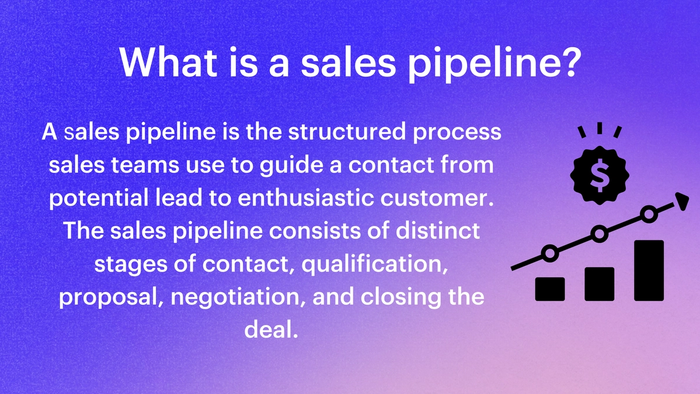The one universal business need, regardless of your business size or industry, is customers.
Breaking the all-or-nothing cycle depends on an effective system to build new customer relationships. If you want to provide the best support to your sales team and get insight into your future revenue, it all starts with a well-crafted sales pipeline.

Wait, I thought that was a funnel?
The terms sales pipeline and sales funnel sometimes get thrown around interchangeably. While a sales pipeline is similar to a sales funnel in that they both track a target customer’s progress toward a sale, these models measure different aspects of the sales process:
The sales pipeline tracks the volume of potential customers and the total value of prospective sales. It’s a great tool to analyze the sales team’s behavior and strengthen processes.
The sales funnel is your best tool to measure rates of conversion for customers. You’ll get a clearer sense of how well your outreach strategies are connecting with your target audience (or where they’re turning away).
5 Tips to build a stronger sales pipeline
Once you develop a clear sales pipeline, you can look ahead to estimate how much new business you’ll generate in upcoming quarters. Try these strategies to pack more power into every step through the sales process.
1. Write ideal customer personas
Tasks are easier to accomplish once you’ve got some momentum, which is why lead generation is named over and over as the biggest sales challenge. CSO Insights found that nearly half of sales reps cited lack of leads as their hardest barrier to effective sales.
Finding the right customer starts with you. You know your business better than anyone, so it’s on you to determine which customers will gain the most from choosing you. Write out a profile for each target customer.
What makes them tick? What are they great at, and what’s their biggest challenge?
The clearer you can envision your ideal customer, the easier it will be to identify and connect with real people who fit the description.
Harry Thomson - Global Account Executive
"A well-structured pipeline mirrors the buyer’s journey, tracking each stage from initial engagement to closing the deal. Are they aware of your product? Have they received a demo? Are they actively using a trial or providing a timeline? By defining clear status stages—right through to payment and user onboarding—you can streamline your sales process and improve forecasting."
2. Prospect for better leads
Finding leads with real potential is an art as much as a science. Timing matters. So do customer pain points, budget, and various other factors that can fluctuate from quarter to quarter.
- Use LinkedIn to find contact info for leads, as well as information about their education and work history that can help you build a more genuine connection.
- Ask for referrals to increase the number of warm connections.
- Do your research. Don’t waste time pursuing deep connections with people who don’t have any decision-making power.
- Aim to know the prospect’s products and services as well as you know your own, so you can offer in-depth insight into why they’re a natural fit.
3. Don’t rush the relationship
Have you ever been accosted by one of those people handing out flyers on the street, only to see an overflowing trash can just a few feet away? Getting too pushy, too fast is an all-but-guaranteed way to lose a sale. While it’s tempting to strike while the iron is hot and jump into a mini-demo at the first sign of interest, resist the urge.
Until you’ve qualified the lead, you don’t know if you’re wasting your time on someone who can’t say yes, even if you nail the presentation.
Start by offering value and nurturing the relationship. Giving leads plenty of information will filter out fruitless opportunities, so you can invest your efforts in qualified leads who are more likely to become customers.
Adrian Mendoza - Global Account Executive
"When creating your sales pipeline, start by reflecting on your current process. With Capsule CRM, you can easily replicate and refine your pipeline while leveraging workflow automation to standardize it across your entire team. This ensures consistency, efficiency, and a seamless experience for both your team and prospects."
4. Standardize your process
Your sales team should tailor parts of their approach to suit each lead, of course. But on a high level, you want the sales pipeline to follow the same process. This is important for a few reasons:
- Easier training for sales reps
- Easier to scale as the business grows
- Improved ability to track results
- Smoother transfer if the sales team needs to redistribute accounts
You’ve developed a process based on your target persona, so the idea is you’re already optimizing the sales pipeline for the best results. The best-performing sales teams tend to work together, rather than having each person create their own method.
5. Review Results
The benefit of developing a healthy sales pipeline for your company is having a concrete system to analyze and improve over time. At least once a year, and more often if you’re a new business or going through a high growth period, review your sales processes and results.
- Are you generating enough leads to close on the level of revenue you need?
- What channel brings in the largest percentage of qualified leads?
- How many times does the sales team reach out before scheduling a demo, or entering negotiation?
- What forms of outreach are getting the best response rate?
- How long does closing a deal take? Which steps take longest, and are there opportunities to shorten that time?
- Review successful pitches. What do they have in common?
Continue to refine your sales pipeline over time, and you’ll keep discovering additional ways to set your business apart from the competition and close deals with confidence.
Need help managing your sales pipeline? Contact us today and let us help you visualize and manage your open sales opportunities and easily determine how your business is doing.




